Designing Healthcare from the Patient’s Perspective
As she pursues her research on what patients really want fromhealthcare providers, Professor Hiroko Komatsu’s involvement in various kindsof nursing care, including incontinence care and cancer nursing, has given herinsights into feelings that patients themselves may have difficultyarticulating. We asked her to tell us about her projects, including theresearch she did before joining the Keio University faculty in 2010.
KOMATSU, Hiroko
Professor
Faculty of Nursing andMedical Care
Graduate School of HealthManagement
Healthcare Initiatives through Patient-to-Patient Support
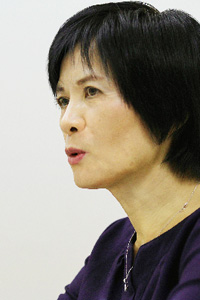
Throughout my career I have been involved in nursing cancerpatients, and my current focus is a study of “peer support” among breast cancerpatients. The distinctive thing about cancer cells is that even after surgery,there may be cells somewhere in the body that have been shed from the originaltumor, and they may gradually take hold. Breast cancer is no exception: evenafter the tumor is excised, if it is an invasive type, cancer cells may havealready spread like dandelion seeds to some other site. To prevent any suchcells from gaining strength, it is necessary to give adjuvant treatment, orpostoperative treatment to increase the chances of curing the disease.Specifically, breast cancer tends to be strongly hormone-sensitive, and so aspart of adjuvant treatment, it is necessary to suppress the body’s naturalestrogen over a period of five to ten years. As a result, even young womenexperience distressing menopause-like symptoms, and at the same time they areliving with the fear of a recurrence. Thus, although patients might look asthough they’re coping well, emotionally they are in a very insecure place. Theymay want to talk to someone about their concerns, but other people cannotempathize fully unless they’ve been there themselves. And so what patients needis an opportunity to hear others who have gone through breast cancer talk abouttheir experiences, pass on what they’ve learned, and provide useful advice, andthis is where “peer supporters” come in. Creating a system to make this kind ofsupport available is an important task we face in practical medical care today.
Supporter Training Programs
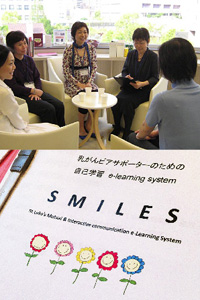 I have been organizing breast cancer support programs and forums since 2003. There has been research done in many countries on the effectiveness of this kind of support. Comparative studies done in the 1980s, for example, showed that cancer patients who participated in support groups suffered less anxiety, and a clear impact on survival rates was even reported. To be effective, however, a group needs a facilitator. This role is often taken on by a healthcare provider or other professional in a related field, but I’m not convinced that this is the best way. I believe we may be able to achieve more by having breast cancer survivors who volunteer as peer supporters provide support both in a group setting and individually, acting as a kind of escort runner or pacesetter. However, this is a responsible position, since the person who takes it on becomes a member of the medical care team. Good intentions alone are not enough. That is why I developed “Smiles,” a self-study program for peer support volunteers, at St. Luke’s College of Nursing, where I taught before coming to Keio.
I have been organizing breast cancer support programs and forums since 2003. There has been research done in many countries on the effectiveness of this kind of support. Comparative studies done in the 1980s, for example, showed that cancer patients who participated in support groups suffered less anxiety, and a clear impact on survival rates was even reported. To be effective, however, a group needs a facilitator. This role is often taken on by a healthcare provider or other professional in a related field, but I’m not convinced that this is the best way. I believe we may be able to achieve more by having breast cancer survivors who volunteer as peer supporters provide support both in a group setting and individually, acting as a kind of escort runner or pacesetter. However, this is a responsible position, since the person who takes it on becomes a member of the medical care team. Good intentions alone are not enough. That is why I developed “Smiles,” a self-study program for peer support volunteers, at St. Luke’s College of Nursing, where I taught before coming to Keio.
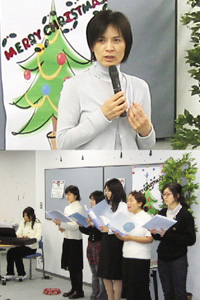 The Smiles is a study program for those who volunteer as part of the St. Luke’s Smile Community, which is run by the volunteers relate to St. Luke’s International Hospital and St. Luke’s College of Nursing. The aim is to prepare oneself through training in the basic knowledge, attitude, and role of volunteers (peer supporters), together with communication skills and basic knowledge about breast cancer treatments, in order to offer support to others with the same diagnosis by acknowledging their feelings and needs and sharing wisdom and courage. The content can be covered in two to three weeks by e-learning, studying for about a half hour a day; after that, the volunteers do role plays to learn how to be supportive in real-life situations. In reality, a patient under intense stress may lash out and say something cutting like “It’s no use talking to you,” but a well-prepared supporter will know how to respond when a patient vents pent-up rage and frustration at her in this way. Peer supporters serve as facilitators in the support program or in volunteer activities for outpatients at St. Luke’s International Hospital. The nursing college students also volunteer: they might act as secretaries for the groups, for example, or get together to sing carols at Christmas. This is greatly appreciated by the patients. I am now getting graduate students from Keio involved too—we work together regardless of our university affiliations.
The Smiles is a study program for those who volunteer as part of the St. Luke’s Smile Community, which is run by the volunteers relate to St. Luke’s International Hospital and St. Luke’s College of Nursing. The aim is to prepare oneself through training in the basic knowledge, attitude, and role of volunteers (peer supporters), together with communication skills and basic knowledge about breast cancer treatments, in order to offer support to others with the same diagnosis by acknowledging their feelings and needs and sharing wisdom and courage. The content can be covered in two to three weeks by e-learning, studying for about a half hour a day; after that, the volunteers do role plays to learn how to be supportive in real-life situations. In reality, a patient under intense stress may lash out and say something cutting like “It’s no use talking to you,” but a well-prepared supporter will know how to respond when a patient vents pent-up rage and frustration at her in this way. Peer supporters serve as facilitators in the support program or in volunteer activities for outpatients at St. Luke’s International Hospital. The nursing college students also volunteer: they might act as secretaries for the groups, for example, or get together to sing carols at Christmas. This is greatly appreciated by the patients. I am now getting graduate students from Keio involved too—we work together regardless of our university affiliations.
A Service That Healthcare Professionals Cannot Provide
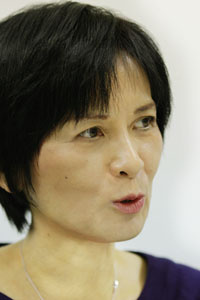 The breast cancer support program has about 2,500 participants atpresent, and the groups meet about once a month. The women who come to thesemeetings have a wide range of concerns, but many are finding it difficult tocome to terms with their diagnosis. Some people may dwell on the question “Whatdid I do wrong?” or “Why me?” until they become depressed. Some say they feltvery isolated and despairing, but when they attended a support group and couldshare their feelings and express themselves freely, they were able to thinkpositively about the future at last. Group members don’t offer one anotherempty reassurances. They know that those facing cancer have to find thestrength in themselves to cope, and so they talk about their own struggle andhow hard it was. That’s something that healthcare providers can’t do. I thinkit is important for that reason to develop a peer support system, to provide aservice that the professionals cannot. In fact, perhaps it should be recognizedas care that is covered by public health insurance. The public pays thepremiums, and I think the insurance system needs to take into account and beprepared to pay for what the public as patients really want in the way of care.That motivates me further to study and document the effects of this kind ofsupport and publish the results.
The breast cancer support program has about 2,500 participants atpresent, and the groups meet about once a month. The women who come to thesemeetings have a wide range of concerns, but many are finding it difficult tocome to terms with their diagnosis. Some people may dwell on the question “Whatdid I do wrong?” or “Why me?” until they become depressed. Some say they feltvery isolated and despairing, but when they attended a support group and couldshare their feelings and express themselves freely, they were able to thinkpositively about the future at last. Group members don’t offer one anotherempty reassurances. They know that those facing cancer have to find thestrength in themselves to cope, and so they talk about their own struggle andhow hard it was. That’s something that healthcare providers can’t do. I thinkit is important for that reason to develop a peer support system, to provide aservice that the professionals cannot. In fact, perhaps it should be recognizedas care that is covered by public health insurance. The public pays thepremiums, and I think the insurance system needs to take into account and beprepared to pay for what the public as patients really want in the way of care.That motivates me further to study and document the effects of this kind ofsupport and publish the results.
Raising Awareness of the Need for Genetic Testing
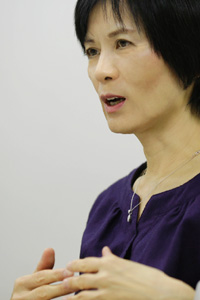 Another focus of my research is hereditary breast and ovarian cancer. The best-known hereditary cancers are cancers of the colon: familial adenomatosis coli and hereditary nonpolyposis colorectal cancer, but there is known to be a large genetic component in some breast and ovarian cancers also. If one inherits the gene from either parent, one tends to have a higher incidence of cancer. In particular, heredity is likely to be a major factor in the development of early-onset breast or ovarian cancer. Thus there is a need for genetic counseling support so that individuals can gain a better understanding of hereditary breast cancer and genetic testing, become aware of their level of risk, and decide for themselves whether to be tested. If a harmful mutation is found, it may have implications not only for the person tested but for their family members as well; thus, support for the whole family is required. Our approach to hereditary breast cancer involves coordination with the Department of Clinical Genetics and the Breast Center at St. Luke’s. The problems we face include difficulty communicating information effectively on the part of medical professionals, and an overreaction to the word “genetic” on the part of patients, which means that uptake of testing tends to remain low. In my research, I am investigating how we can improve awareness of the need for genetic testing, what we need to do to overcome this fear and reluctance, in the hope of proposing a new care system.
Another focus of my research is hereditary breast and ovarian cancer. The best-known hereditary cancers are cancers of the colon: familial adenomatosis coli and hereditary nonpolyposis colorectal cancer, but there is known to be a large genetic component in some breast and ovarian cancers also. If one inherits the gene from either parent, one tends to have a higher incidence of cancer. In particular, heredity is likely to be a major factor in the development of early-onset breast or ovarian cancer. Thus there is a need for genetic counseling support so that individuals can gain a better understanding of hereditary breast cancer and genetic testing, become aware of their level of risk, and decide for themselves whether to be tested. If a harmful mutation is found, it may have implications not only for the person tested but for their family members as well; thus, support for the whole family is required. Our approach to hereditary breast cancer involves coordination with the Department of Clinical Genetics and the Breast Center at St. Luke’s. The problems we face include difficulty communicating information effectively on the part of medical professionals, and an overreaction to the word “genetic” on the part of patients, which means that uptake of testing tends to remain low. In my research, I am investigating how we can improve awareness of the need for genetic testing, what we need to do to overcome this fear and reluctance, in the hope of proposing a new care system.
Seeking New Encounters at Keio
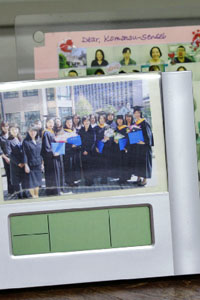 Care of urinary incontinence has been a lifelong focus of my work, and women patients in that setting have talked to me about many things they feel unable to tell their doctor. Through my research on “people-centered care,” also, I have advocated for medical care that is more grounded in respect for the individual concerned. Over the years, with these experiences as a basis, I have sought answers as to what kind of care truly satisfies the patient—the person from whose perspective care should be viewed—and what kind of medical system it takes to deliver that care. The more I pursued scientific studies in these areas, the more strongly I felt the need to be at a general university rather than a nursing college, so that I could do interdisciplinary research, and that is why I came to Keio University in 2010. In medical care which incorporates the patient’s perspective, information is very valuable. This means that I need a team situation, with experts working across disciplines, if my current research is going to have more of a social impact, and Keio is the ideal environment for that. The students benefit in the same way, and I certainly hope that they will take part in these activities and experience the joint effort we bring to bear on problem-solving.
Care of urinary incontinence has been a lifelong focus of my work, and women patients in that setting have talked to me about many things they feel unable to tell their doctor. Through my research on “people-centered care,” also, I have advocated for medical care that is more grounded in respect for the individual concerned. Over the years, with these experiences as a basis, I have sought answers as to what kind of care truly satisfies the patient—the person from whose perspective care should be viewed—and what kind of medical system it takes to deliver that care. The more I pursued scientific studies in these areas, the more strongly I felt the need to be at a general university rather than a nursing college, so that I could do interdisciplinary research, and that is why I came to Keio University in 2010. In medical care which incorporates the patient’s perspective, information is very valuable. This means that I need a team situation, with experts working across disciplines, if my current research is going to have more of a social impact, and Keio is the ideal environment for that. The students benefit in the same way, and I certainly hope that they will take part in these activities and experience the joint effort we bring to bear on problem-solving.
Profile of Professor KOMATSU, Hiroko
Hiroko Komatsu was appointed professor of Adult Nursing at the St. Luke’s College of Nursing in 1994. In 2004, she became program leader of the St. Luke’s College of Nursing 21st Century COE Program, and in 2007 she was appointed coordinator manager of the college’s Cancer Professional Training Plan. Since 2010, she has been a professor in the Faculty of Nursing and Medical Care and the Graduate School of Health Management of Keio University.
Professor Komatsu chairs the Board of Directors of the Japan Academy of Nursing Science and serves on the boards of the Japanese Society of Cancer Nursing, the Japan Society of Nursing Research, the Japan Association for Bioethics, the Japan Society for Menopause and Women’s Health, and the Japanese Society for Clinical Thanatology. She is a member of the Science Council of Japan and vice president of the Japan Association of Nursing Academies.
Faculty webpage:
(15 February 2012)
